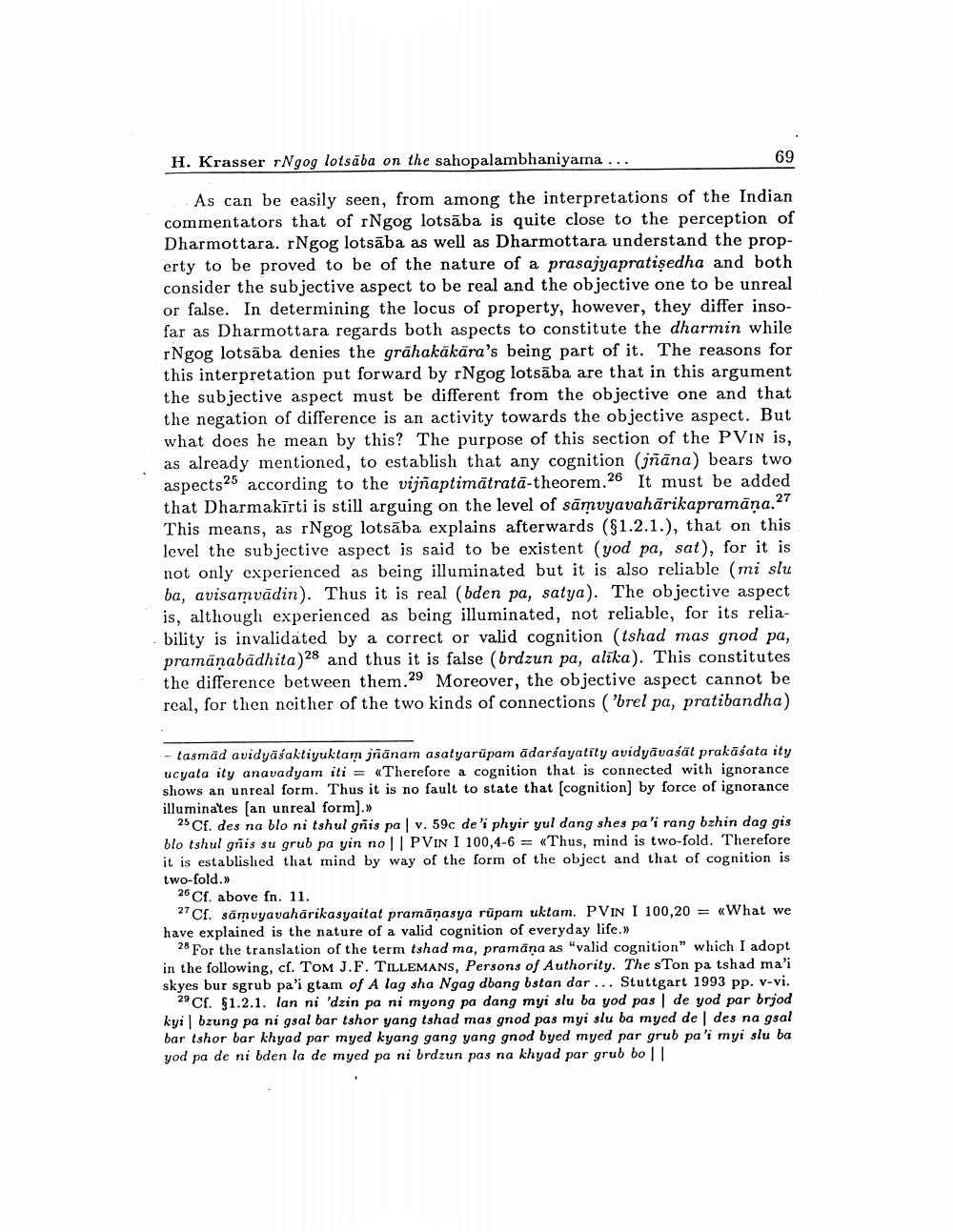Book Title: Rngog Lotsaba On Sahopalambhaniyama Proof In Dharmakirtis Pramanaviniscaya Author(s): Helmut Krasser Publisher: Helmut Krasser View full book textPage 7
________________ H. Krasser rNgog lotsāba on the sahopalambhaniyama... 69 As can be easily seen, from among the interpretations of the Indian commentators that of Ngog lotsāba is quite close to the perception of Dharmottara. rNgog lotsāba as well as Dharmottara understand the property to be proved to be of the nature of a prasajyapratişedha and both consider the subjective aspect to be real and the objective one to be unreal or false. In determining the locus of property, however, they differ insofar as Dharmottara regards both aspects to constitute the dharmin while rNgog lotsāba denies the grāhakākāra's being part of it. The reasons for this interpretation put forward by rNgog lotsāba are that in this argument the subjective aspect must be different from the objective one and that the negation of difference is an activity towards the objective aspect. But what does he mean by this? The purpose of this section of the PVIN is, as already mentioned, to establish that any cognition (jñāna) bears two aspects25 according to the vijñaptimātratā-theorem.26 It must be added that Dharmakīrti is still arguing on the level of sāmvyavahārikapramāņa.27 This means, as rNgog lotsāba explains afterwards ($1.2.1.), that on this level the subjective aspect is said to be existent (yod pa, sat), for it is not only experienced as being illuminated but it is also reliable (mi slu ba, avisamvādin). Thus it is real (bden pa, satya). The objective aspect is, although experienced as being illuminated, not reliable, for its reliability is invalidated by a correct or valid cognition (tshad mas gnod pa, pramāṇabadhita)28 and thus it is false (brdzun pa, alika). This constitutes the difference between them.29 Moreover, the objective aspect cannot be real, for then neither of the two kinds of connections ('brel pa, pratibandha) - tasmäd avidyāśaktiyuktam jñānam asatyarūpam ādarśayatīty avidyāvaśāt prakāśata ity ucyata ity anavadyam iti = «Therefore a cognition that is connected with ignorance shows an unreal form. Thus it is no fault to state that (cognition) by force of ignorance illuminates (an unreal form). 25 Cf. des na blo ni tshul gñis pa v. 59c de'i phyir yul dang shes pa'i rang bzhin dag gis blo tshul gñis su grub pa yin no|| PVIN I 100,4-6 = «Thus, mind is two-fold. Therefore it is established that mind by way of the form of the object and that of cognition is two-fold. 26 Cf. above fn. 11. ? Cf. sāņuyavahārikasyaitat pramāṇasya rūpam uktam. PVIN I 100,20 = «What we have explained is the nature of a valid cognition of everyday life.» 28 For the translation of the term tshad ma, pramana as "valid cognition" which I adopt in the following, cf. TOM J.F. TILLEMANS, Persons of Authority. The ston pa tshad ma'i skyes bur sgrub pa'i gtam of A lag sha Ngag dbang bstan dar... Stuttgart 1993 pp. v-vi. C. 1.2.1. lan ni dzin pa ni myong va dang mui slu ba vod pas | de god par brjod kyi bzung pa ni gsal bar tshor yang tshad mas gnod pas myi slu ba myed de des na gsal bar tshor bar khyad par myed kyang gang yang gnod byed myed par grub pa'i myi slu ba yod pa de ni bden la de myed pa ni brdzun pas na khyad par grub bo ||Page Navigation
1 ... 5 6 7 8 9 10 11 12 13 14 15 16 17 18 19 20 21 22 23 24 25 26
